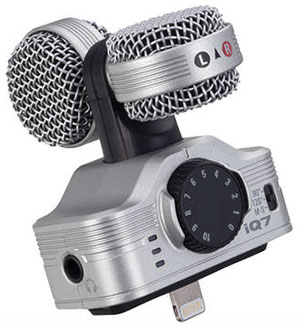New Zoom Mid-Side Stereo iPhone Mic Now Available
[UPDATE: this was a few years ago. But the good news is that this very cool mic is still available.
Announced at the 2015 Winter NAMM (National Association of Music Merchants) trade show, the new mid-side stereo mic iPhone attachment – the Zoom iQ7 – is available as of today at B&H.
Why is this such a big deal? There are plenty of stereo mics out there that can attach to the iPhone these days. But this is the first mid-side stereo attachment mic that I’ve seen. And THAT is what makes it such a big deal.
Mid-Side Versus “Regular” Stereo
So what is so special about this thing I keep calling “mid-side (M/S)?” And what the heck does M/S mean anyway? In a nutshell (see our article “5 Audio Recording Tips For Newbies – Part 1: Stereo Or Not?” for a primer on stereo recording), stereo mics are usually set up to where two microphones are pointing in different directions toward the subject.
The idea there is to try and mimic the way a human head (specifically the ear parts of the head) picks up sound naturally, that is from slightly different places in space (the left and right sides of your head). So two mics will theoretically provide timing cue differences which your brain will convert into a more spacious, more natural sound than a mono or “point’ sound source.
The problem with the traditional two-mics-pointing-in-slightly-different-directions method is that once it’s recorded, you have very little flexibility to change the stereo “image.” But with M/S, which is typically a bit more complicated to do (you need two different types of mics – a figure-8 mic and a cardioid mic – and they have to be set up in a very particular way), you not only get a wonderful stereo sound, but you can adjust the width of the stereo image after the fact!
M/S is the preferred stereo technique for broadcast recording, mainly because when the two stereo channels are converted to mono (as is often done for radio), the audio doesn’t suffer.
With standard stereo techniques, you often get phase cancelation problems (meaning “the audio sounds odd”) when converted from stereo to mono. M/S is also often used for live recording because of how much control you have over the stereo field in the mixing stage. There is a nice article about M/S stereo recording on the Universal Audio (UA) site here: https://www.uaudio.com/blog/mid-side-mic-recording/
So THAT is why I’m so excited about this brand new microphone attachment for the iPhone. The iQ7 works with the newer devices that use the lightning connector. And the price is fantastic at just $99.99 at B&H. CLICK HERE to find out more or to order one for your very own!

